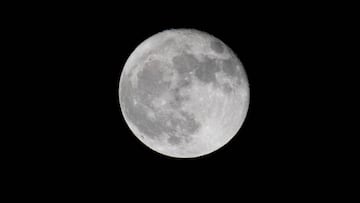When will the next pink moon be visible in the USA?
The second full moon of the spring will be visible along with other celestial bodies this month. Here’s all you need to know.


The Pink Moon is set to be visible along with Mars, Saturn and Mercury from Tuesday this week until Thursday.
The US Naval Observatory announced that the visible on Tuesday and become the fullest at around 7:49 p.m. EDT and can be best seen just at moonrise.
The Pink Moon rises behind the Statue of Liberty in New York City, Monday evening #newyorkcity #nyc #newyork #PinkMoon #moon #statueofliberty pic.twitter.com/CzTSjgjmt9
— Gary Hershorn (@GaryHershorn) April 23, 2024
Why is it called the Pink Moon?
Unfortunately, this phase of the moon is not actually pink. NASA says that “the tribes of the northeastern United States called this the Pink Moon, named after the herb moss pink, also known as creeping phlox, moss phlox, or mountain phlox, a plant native to the eastern USA that is one of the earliest widespread flowers of spring”.
It is the fourth full moon of the year and the second full moon of spring; as well as the Pink Moon, it’s also known as Sprouting Grass Moon, Egg Moon, Fish Moon, the Pesach or Passover Moon, with the latter coming from the beginning of the Jewish holiday Passover.
It’s okay if you don’t feel sparkly today. It's cool if you're not feeling it. Step back for a bit. There’s just one problem.
— NASA (@NASA) April 18, 2024
You already sparkle. Maybe you don’t see it, but others do. You belong, just like every star in this star cluster belongs. pic.twitter.com/PCQKEDOn68
What planets can you see alongside the Pink Moon?
NASA says that one should keep an eye out for various planets that can be seen alongside the Pink Moon.
On the morning of Tuesday, April 23, 2024 (the morning of the day of the full Moon), as twilight begins (at 5:18 AM EDT), Mars will be 5 degrees above the eastern horizon.
Related stories
Saturn, at this time, will be 7 degrees above the east-southeastern horizon while Mercury will rise 22 minutes after morning twilight begins on Tuesday, April 23, 2024.
As twilight ends that evening (at 8:56 PM EDT), the rising Moon will be 10 degrees above the east-southeastern horizon. The bright planet Jupiter will be 4 degrees above the west-northwestern horizon” NASA says. The planets will shift slowly westward as the lunar cycle progresses.


Complete your personal details to comment